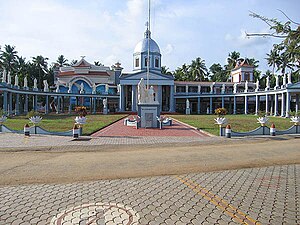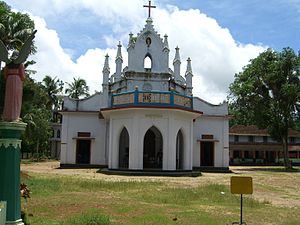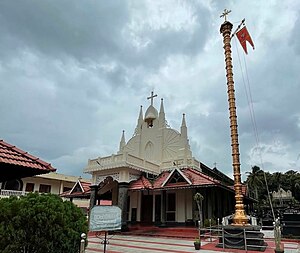Ēḻarappaḷḷikaḷ
Ezharappallikal, meaning seven and a half royal churches, are the seven major churches or Christian communities of Saint Thomas Christians across Malabar Coast of India that are believed to have been founded by Thomas the Apostle in the first century.[1] According to Indian Christian traditions, the Apostle Thomas arrived in Muziris (Kodungallur) in AD 52, established the Ezharappallikal (Seven royal churches or Seven and a half Churches) and evangelised in present-day Kerala and Tamil Nadu.[2][3][4] Many of these churches built near Jewish and Brahmin settlements. These were at Maliankara (Kodungallur), Kollam, Palayoor, Kottakkayal (North Paravur or Kottakkavu), Kokkamangalam, Niranam and Nilackal (Chayal).[5][6] Thiruvithamcode church in Kanyakumari was built on the land given by arachan (king) and hence it is often referred in the name Arappally (half church).[7][8][9][10] Similarly, the Churches at Malayattoor and Aruvithura are also referred to as Arappallikal.[7]
Ezharappallikal
The seven churches are located at Kodungallur, Kollam, Palayoor, Kottakkavu (Paravoor), Kokkamangalam (South Pallippuram), Niranam and Nilackal (Chayal).[6]
Kodungallur
The Kodungallur church is considered to be the oldest church built by St. Thomas on the Malabar Coast.[6] Kodungallur is known in various names such as Muziris, Muchiri, Muyirikkode, Shengala, Shinjli, Makottai, Mahadevarpattanam and Cranganore. The Church at Kodungallur rose to prominence after the fall of the Christian community in the Coromandel Coast, especially Mylapore.[11] Francisco Roz, the first latin Archbishop of Saint Thomas Christians, describes Cranganore as the most ancient episcopal see in India.[6] Cranganore had three churches, namely, the Church of Saint Mary, the Church of Saint Thomas and the Church of Saint Quriakose. The Church of Saint Thomas was constructed by Thomas of Cana, a Christian merchant who arrived in Cranganore. The Church of Saint Quriakose was the Cathedral Church of the Metropolitan of Saint Thomas Christians. The Church of Saint Mary is believed to be the one originally founded by Saint Thomas.
This holy book has been copied in the royal, renowned and famous town Shengala, which is in Malabar in the land of India, in the holy Church dedicated to the Mar Quriaqos, the glorious martyr... whilst our blessed and holy father Mar Yahballaha the Fifth, the Turk, qatoliqa Patriakis of the East... and when Mar Jacob, Metropolitan Bishop was the overseer and governor of the holy see of Saint Thomas the Apostle, that is to say governor of us and of all the holy Church of the Christian India....
— Zakhariya bar Joseph, MS Vatican Syriac 22, ff. 93r-94v[12]
1604, Francisco Roz wrote a report on the Saint Thomas Christians in which he quotes an account of the three churches in Cranganore.[13]
In the old manuscript book of prayer of a Church of Mangate, I found written at the end how the said book was made and written at Cranganore, where it says there were three churches, one of Saint Thomas, another of Our Lady, and another of Saint Cyriac, I say Saint Cyriac, a martyr-child, the son of Saint Julita, and very famous among these Chaldeans, whose feast they celebrate on the fifteenth of July. According to the era in which the said book was written, it was written ninety-seven years before this year of 1604.
— Francisco Roz, MS Add 9853, ff. 85–99[14]
The current Marthoma Pontifical shrine (Kodungaloor Mar Thoma Church) church is situated on the banks of the River Periyar about 6 km from Kodungallur, in the village of Azhikode in Kerala.[15]
Palayur
St. Thomas Church, Palayoor is located at Palayur (also spelled Palayoor), in Thrissur district in Kerala on the west coast of India. According to tradition, it was established in 52 AD by St Thomas. It is the first church in India, and is called an Apostolic Church credited to the Apostolate of St. Thomas who preached and also started the conversion of people to Christianity here.[6]
Pierre du Jarric gives part of a letter by James Fenicio, a Jesuit missionary in the Zamorin's territory.[16][17][18]
As the church of Palur dedicated to Saint Cyriac [Quriaqus], which was the oldest (primus) among all the churches in Malabar, and renowned for favours and graces obtained, and for this reason much frequented, I devoted myself more especially to it. The stone church which I began two years ago [enclosing, apparently, within it the primitive building] had risen to the height of the windows. At this stage no one would dare to pull down the old wooden building, fearing to be struck down by sudden death: it stood surrounded by the walls of the new erection, but after I had prayed and removed their timidity, the old structure was pulled down, and the new building stood out in such fine proportions that the Hindus, the Mahomedans, and the Jews flocked to see it.
— Jarric 1615, p. 50–51
Kottakkavu
Kottakkavu Church was established by St. Thomas in North Paravur in the Ernakulam district. It is considered to be one of the oldest Church in Kerala. The church of Kottakkavu was rebuilt in the 9th century. It was renovated for the third time in 1308. Pope Gregory XIII raised the altar of this church to the status of privileged altar in 1575.[6] The church was originally dedicated to Saints Sabor and Aproth. The Synod of Diamper removed the their names and dedicated the church to Gervasius and Protasis.
MS Vatican Syriac N. iv., dated A.D. 1556, has the following colophon in folio 278:
"By the help of our Lord we have finished this book of the Prophets; it was written on a Monday, the 18th of February, in the year 1556 of the birth of our Lord. I, priest Jacob, the disciple of Mar Jacob, and from the village of Puraur, have written this book in the holy Church of Mar Shapur and Mar Iapot [Piruz]. May the holy name of God be praised for ever. Amen!"
— MS Vatican Syriac N. iv.[19]
Kokkamangalam
Kokkamangalam church (or Gokkamangalam church) is situated at Gokkamangalam near Cherthala in the Alappuzha district. St. Thomas sailed to Gokkamangalam where he preached the gospel for about a year. 1600 people converted to Christianity through him according to the narration in "Rampan Pattu", an ancient form of Christian folksong prevalent in Kerala. He formed a Christian community at Kokkamangalam and enshrined a cross for the faithful.[7]
Nilakkal
Nilakkal is a village, roughly 52 km (32 mi) east to Ranni and near Sabarimala in Pathanamthitta district. This church area was discovered during the time of Malankara Metropolitan Pulikottil Thirumeni (then head of the Orthodox Church). For the harmony of ecumenism among St Thomas Christians, then leadership of the Orthodox church paved the way to dedicate the church for all denominations. It was a mountain route of trade between Kerala and Tamil Nadu. Saint Thomas accompanied by Habban came over here and baptised 1100 people.[7]
Niranam
Niranam Pally is one of the oldest churches in Kerala. It is believed that the church was founded by St. Thomas, in AD 54 at Niranam near Thiruvalla in Pathanamthitta district. The church was reconstructed several times since then. The stones in the church show the reconstruction in 1259. On his way from Kollam, he arrived at Niranam (Thrikpapaleswaram) by sea. He converted two Hindu Brahmin families named Pattamukkil and Thayyil and two Nair families named Manki and Madathilan to Christianity. He also gave priestly powers to the members of Pattamukkil family.
It is believed to be one of the oldest churches in Kerala and thus in India as well as among the oldest ones in the world. The architecture shows striking similarities to ancient temple architecture.[20][6]
Kollam
In ancient times, Kollam was a famous harbour and trade centre. According to local tradition, St. Thomas established a church near the port, which is believed to have been destroyed by the Arabian Sea.[6][7] Those temporarily living near the church migrated towards Thevalakkara and constructed a new church there. Martha Mariam Orthodox Syrian Church of Thevalakkara is one of the main churches near Kollam. It is situated in Karunagapally Taluk within Kollam district. The church is located 5 km (3.1 mi) east of Chavara Kuttivattom junction and 6 km (3.7 mi) west of Sasthamkotta.
Arappallikal
The churches at Thiruvithamkode, Malayattoor, and Aruvithura are referred to as Arappallikal, which may be translated either as Half churches or Royal churches.[7]
Thiruvithamkode
Thiruvithamcode St Marys Orthodox Church (Arapalli) or Thomayar Kovil, is located in Thiruvithamcode, Tamil Nadu, India, 30 km to the south of the Kerala state border. It is believed by the Christian communities in Kerala that the historic Thiruvithamcode Arappally, also called Amalagiri church as named by the Chera King Uthiyan Cheralathan, was built by St. Thomas, known as the Apostle of India, in AD 52.AD
Malayattoor
St. Thomas is believed to have returned to Malankara coast via Malayatur where he establishes ‘the half church’ (a small Christian community dependent on the Church of Maliamkara). Oral tradition says that while travelling through Malayattor, faced with hostile natives, he fled to the hilltop where he said to have remained in prayer and that he left his footprint on one of the rocks. According to beliefs, during prayer, he touched a rock, upon which blood poured from it.[7]
Aruvithura
It is believed that St. Thomas visited Irapeli and converted a prominent families into Christianity and laid a cross on the banks of the Meenachil River. Local traditions also support this belief. This is the first church in the Palai diocese and was built in the 1st century. St. Thomas founded seven and a half churches there. The 'half' church refers to a cross laid at Irapoli by St. Thomas, making the church of Irapeli the half church.[7] It is reported that the church was rebuilt once or twice before the 16th century. The ancient churches were constructed and maintained by the prominent families in the area until the 16th century. In the beginning of the 16th century a new church was built under the leadership of Kallarackal Kathanar by the prominent families. The church was first dedicated to the Assumption of Saint Mary. In the 14th century when either the Nilackal Church or the Chayal Church founded by St. Thomas was destroyed, several families migrated to Irapeli bringing with them a statue of St. George. Gradually the church itself was re-dedicated to Saint George.
References
- ^ Hill, John (1963). "1-South India". The Rockliff New Project - Illustrated Geography - The Indian Sub-Continent. London: Barrie & Rocklife. p. 28.
- ^ Stephen Andrew Missick. "Mar Thoma: The Apostolic Foundation of the Assyrian Church and the Christians of St. Thomas in India" (PDF). Journal of Assyrian Academic Studies. Archived from the original (PDF) on 27 February 2008. Retrieved 5 March 2016.
- ^ Origin of Christianity in India – A Historiographical Critique by Dr. Benedict Vadakkekara. (2007). ISBN 81-7495-258-6.
- ^ Fahlbusch, Erwin (14 February 2008). The Encyclodedia of Christianity. Wm. B. Eerdmans Publishing. ISBN 9780802824172.
- ^ William, Logan (1887). "The People: Religion: Christianity". Malabar Manual. I: 199. ISBN 9781976845260.
- ^ a b c d e f g h Whitehouse (1873).
- ^ a b c d e f g h Department of Tourism.
- ^ "The First Church in Tamil Nadu | Ara Palli, Thiruvithancode". Online Kanyakumari. 7 August 2015. Retrieved 5 March 2016.
- ^ "About Syro Malabar Church". St Joseph Syro Malabar Catholic Mission of Hudson Valley, New York.
- ^ "St Thomas the Apostle and His Seven and a Half Churches".
- ^ Perczel, István (2018). Daniel King (ed.). Syriac Christianity in India. The Syriac World. Routledge. p. 657. ISBN 9781317482116.
- ^ Van der Ploeg, J. P. M. (1983). The Christians of St. Thomas in South India and their Syriac Manuscripts. Rome; Bangalore: Center for Indian and Inter-Religious Studies; Dharmaram Publications. p. 3–4.
- ^ Vellian, Jacob (1986). Symposium on the Knanites. pp. 13–20.
- ^ Vellian (1986), p. 20.
- ^ "Marthoma Church at Azhikode, Marthoma Pontifical Shrine | Religious sites at Muziris Heritage Area, Ernakulam". www.muzirisheritage.org. Retrieved 5 March 2016.
- ^ Jarric, Pierre du (1615). Thesaurus rerum Indicarum. Sumptibus Petri Henningii. p. 50-51. ISBN 9781166491291.
- ^ Medlycott, Adolphus E. (1905). India and the Apostle Thomas: An Inquiry, with a Critical Analysis of the Acta Thomae. p. 30 note. ISBN 9781463208530.
- ^ Menachery, George. "Indianchristianity".
- ^ Mingana, Alphonse (1926). "The Early Spread of Christianity in India" (PDF). Bulletin of the John Rylands Library. 10 (2): 502. doi:10.7227/BJRL.10.2.7.
- ^ "History of Niranam Valiapally". niranamchurch.com. Archived from the original on 4 March 2016. Retrieved 5 March 2016.
- Whitehouse, Thomas (1873). Lingerings of light in a dark land: Researches into the Syrian church of Malabar. William Brown and Co. p. 23-42.
Though Cranganore and Quilon are always mentioned amongst their earliest and most important settlements, five other places are named in conjunction with them, viz., Palúr, North Parúr, South Pallipuram, Neranum, and Nellakkul. The whole group are traditionally styled the Seven Churches founded by St. Thomas the Apostle.
- Department of Tourism, Government of Kerala. "Seven and half Churches (Ezhara Pallikal)".
Further reading
- A.C. Perumalil, The Apostles in India, Patna (India), XTTI, 1971.
- George Menachery, Ed.,"The St.Thomas Christian Encyclopaedia of India", esp. Vol.2, 1973.
- George Menachery, Ed.,"The Nazranies", Indian Church History Classics, Vol. 1, 1998, esp. books fully reproduced in it by Mackenzie, Medlycott, Farquar, and many others.











